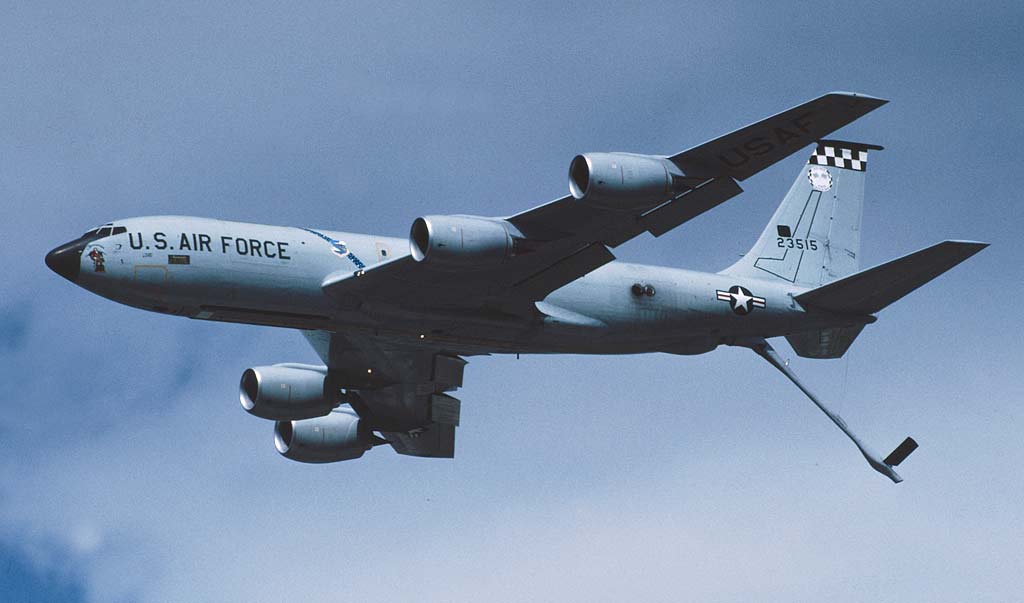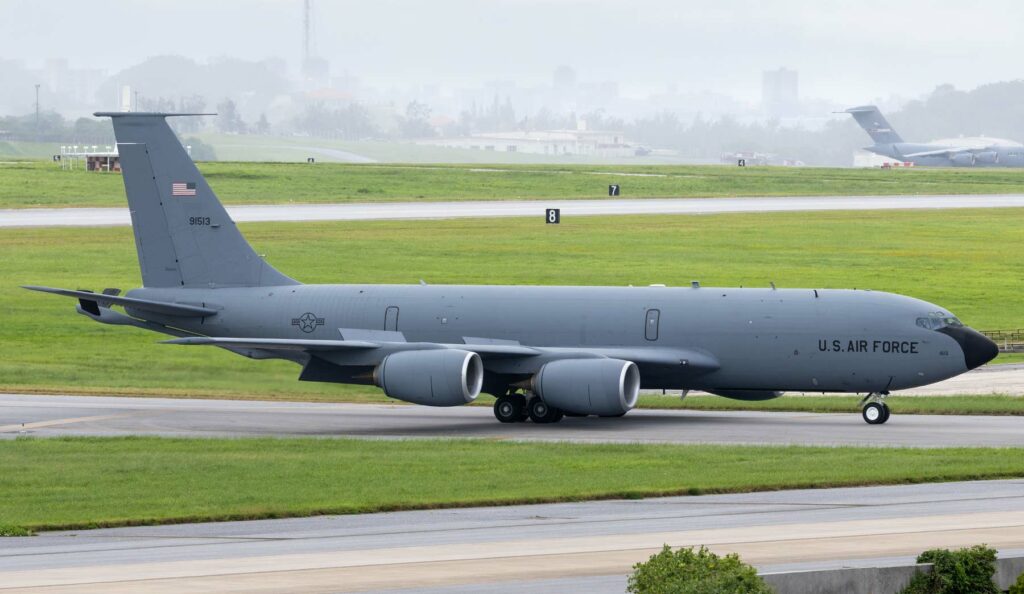The KC-135 Stratotanker is a key aerial refueling aircraft with multi-role capabilities, pivotal for extending the range of military aviation globally.
Technical Summary
The Boeing KC-135 Stratotanker is a military aerial refueling aircraft that has been a cornerstone of the United States Air Force’s (USAF) strategic capabilities since the 1950s. Developed from Boeing’s 367-80 jet transport prototype, the KC-135 was the first jet-powered air refueling tanker. It features a flying boom system for fuel transfer, four turbofan engines, and a capacity to carry up to 200,000 pounds of fuel. With a crew of three to four, depending on the mission, the Stratotanker can also transport cargo, passengers, and perform medical evacuation. Over its operational lifespan, the KC-135 has undergone numerous upgrades to enhance its avionics, engines, and refueling systems, ensuring its continued relevance in modern air operations.
The Boeing KC-135 Stratotanker represents a significant achievement in military aviation, providing the United States Air Force (USAF) with unparalleled air refueling capabilities that have extended the operational range and endurance of combat and reconnaissance aircraft for over six decades.

History of the Development of the Boeing KC-135 Stratotanker
In the early 1950s, as the Cold War intensified, the USAF recognized the need for a more efficient and capable air refueling platform to support its growing fleet of jet-powered bombers and fighters. This requirement was driven by the strategic necessity to project air power across the globe and ensure bombers could reach their targets without the limitations imposed by their internal fuel capacities.
The development of the KC-135 Stratotanker was initiated by Boeing in response to this need. Building on the success of the Boeing 367-80, or “Dash 80,” prototype—a jet designed to demonstrate the feasibility of jet transport—Boeing adapted the design to meet the specific requirements of aerial refueling. The program officially began in 1954, and the KC-135 made its first flight on August 31, 1956. It was quickly adopted by the USAF, with the first Stratotanker delivered in June 1957.
The introduction of the KC-135 marked a pivotal moment in aerial refueling technology. Its jet-powered design represented a significant departure from the slower, propeller-driven tankers previously in use, offering greater speed, altitude compatibility with jet bombers and fighters, and a more efficient flying boom refueling method. This capability fundamentally changed the strategic calculus of air operations, enabling global reach and sustained air presence in a way that was previously unimaginable.
Design of the Boeing KC-135 Stratotanker
The KC-135 Stratotanker’s design is characterized by its four-engine jet configuration, utilizing either Pratt & Whitney J57-P-59W turbojets in early models or CFM International CFM56 turbofans in later upgrades, known as the re-engined KC-135R and KC-135T variants. These engines provide the power necessary for the aircraft to carry up to 200,000 pounds (90,718 kilograms) of fuel, offering a maximum takeoff weight of about 322,500 pounds (146,285 kilograms).
The aircraft’s dimensions include a wingspan of 130 feet 10 inches (39.88 meters), a length of 136 feet 3 inches (41.53 meters), and a height of 41 feet 8 inches (12.70 meters). The Stratotanker’s design also incorporates a distinctive flying boom system for refueling, which is operated by a boom operator stationed at the rear of the aircraft. This system allows for faster, more efficient fuel transfer compared to the probe-and-drogue method used by some other refuelers.
One of the key advantages of the KC-135’s design is its flexibility. In addition to its primary refueling role, the aircraft can be configured to transport cargo, passengers, or perform aeromedical evacuations, making it a versatile asset for a variety of missions. However, its age and design limitations have necessitated ongoing upgrades to maintain operational efficiency and compatibility with modern aircraft.
Performance of the Boeing KC-135 Stratotanker
The KC-135 Stratotanker’s performance is marked by its ability to conduct extended air refueling missions at high altitudes and speeds compatible with modern jet fighters and bombers. The re-engined KC-135R variant, for example, is powered by CFM International CFM56 turbofan engines, each providing significantly more thrust than the original J57 turbojets. This upgrade has improved the Stratotanker’s fuel efficiency, reduced noise, and increased its range and payload capacity.
The KC-135 can reach a maximum speed of about 530 mph (853 km/h), with a cruising speed of 530 mph at 30,000 feet (9,144 meters). Its operational range exceeds 1,500 miles (2,414 kilometers) with 150,000 pounds (68,039 kilograms) of transferable fuel, extending further when less fuel is carried or through in-flight refueling. The aircraft’s service ceiling is around 50,000 feet (15,240 meters), allowing it to operate above commercial air traffic and most weather conditions.
When compared to its contemporaries and successors, such as the McDonnell Douglas KC-10 Extender and the Boeing KC-46 Pegasus, the KC-135 maintains a critical role due to its proven reliability and extensive upgrade potential. While newer models offer improvements in fuel capacity, range, and multi-role capabilities, the KC-135’s widespread availability and historical significance have ensured its continued use in the USAF’s fleet.
Variants of the Boeing KC-135 Stratotanker
The KC-135 family includes several variants, each tailored to specific mission requirements. The original KC-135A model, powered by J57 turbojets, laid the foundation for subsequent modifications. The most significant upgrade came with the KC-135R and KC-135T re-engined variants, which feature CFM56 turbofan engines for enhanced performance. Other specialized variants include the KC-135E, which received upgraded but older TF33 engines, and the NC-135 and WC-135 used for research and weather reconnaissance, respectively.
The diversity of the KC-135 variants demonstrates Boeing and the USAF’s commitment to adapting and optimizing the Stratotanker for a range of operational needs, from aerial refueling to scientific research and surveillance.

Military Use and Combat of the Boeing KC-135 Stratotanker
Throughout its service life, the KC-135 Stratotanker has been a critical asset in numerous military operations and conflicts, providing essential aerial refueling support that has extended the reach of US and allied air forces. Its operational debut during the Vietnam War showcased its strategic importance, enabling sustained bombing campaigns and fighter patrols over Southeast Asia.
In subsequent conflicts, including Operations Desert Storm, Iraqi Freedom, and Enduring Freedom, the KC-135 played a vital role in maintaining air superiority and supporting ground operations through its refueling capabilities. The Stratotanker’s ability to refuel a wide variety of aircraft, from fighters like the F-16 Fighting Falcon to large bombers such as the B-52 Stratofortress, has made it indispensable in both conventional and unconventional warfare scenarios.
The KC-135 has also participated in NATO operations, providing aerial refueling support to allied forces and demonstrating the aircraft’s versatility and interoperability with various air platforms. Its contributions have not been limited to combat operations; the KC-135 has been involved in humanitarian missions, disaster response, and space shuttle support operations, further highlighting its multifaceted role in military and civil endeavors.
The Boeing KC-135 Stratotanker’s development, design, and operational history underscore its pivotal role in transforming aerial refueling and extending the strategic reach of the United States Air Force and its allies. As one of the most enduring and versatile aircraft in the USAF’s inventory, the KC-135 has adapted to evolving military needs through continuous upgrades and modifications. Its legacy, marked by over six decades of service, exemplifies the importance of innovation and adaptability in ensuring the effectiveness and longevity of military assets.
Back to Transport planes.